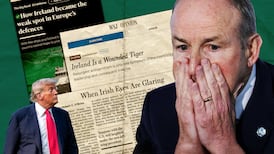The election campaign finally shifted up a gear in recent days with Fine Gael taking the fight to its opponents after a series of disappointing poll results.
Big guns Michael Noonan, Leo Varadkar and Simon Coveney have been wheeled out to try to generate the momentum that has been lacking in the party’s campaign.
At this stage the election race has entered the phase memorably described by Alex Ferguson as “squeaky-bum time”. While a succession of polls are indicating stalemate as the most likely outcome, a lot can change in the final week.
From the beginning the Coalition parties have tried to frame the choice facing the electorate as stability versus chaos, but they have not been getting much traction for the proposition. However, at the very least voters are facing a choice between the known and the unknown.
In recent days Fine Gael has changed the emphasis of its core message – keep the recovery going. That slogan has so far failed to gain much traction with voters so Noonan shifted tack at a major press conference on Thursday by emphasising the need to ensure that people felt the recovery in their pockets.
He framed the party’s pledge to abolish the universal social charge (USC) as a key element of this strategy. “We know that the recovery is not being felt by everybody and our ambition is to make it felt in every home. The principal mechanism to do that is to abolish USC so that everybody can benefit from the recovery.”
Fine Gael and Noonan have come in for criticism from some of their more traditional supporters for making so many promises at the outset of the campaign.
“This is not the Fine Gael of Paddy McGilligan or Liam Cosgrave,” observed one life-long Fine Gael supporter, appalled at the party’s manifesto.
The response to that is that neither McGilligan nor Cosgrave managed to win elections coming out of government. The espousal of traditional Fine Gael virtues of prudence and economy would hardly gain much traction with today’s electorate either.
An election campaign fresher in the minds of Kenny and Noonan is that of 1997 when they were both ministers in John Bruton’s rainbow coalition. Having run a successful and financially-prudent government they went into the election campaign making modest promises but were beaten by the more extravagant tax-cutting pledges by Fianna Fail and the Progressive Democrats.
Getting the balance right between making attractive but affordable promises was the task facing Fine Gael in the run-up to this election yet it managed to muck it up at the start of the campaign by not appearing to know how its own figures added up.
Fianna Fáil capitalised on Fine Gael confusion, and Micheál Martin has grown in confidence as the campaign progressed. Fianna Fáil TDs have been reporting a good response at the doors, and Fianna Fáil has pulled ahead of Sinn Féin in the polls.
Knows best
Fine Gael’s assault on the Fianna Fáil manifesto figures in recent days showed increasing worry about the old enemy making a significant comeback.
At this stage the electorate is probably bamboozled by all the contradictory promises and figures floating around, and the challenge facing every party is how to convince people it knows best.
The Fine Gael argument was put neatly by Simon Coveney. “We have a track record over the past five years so our figures are credible. Compare that to the record of Fianna Fáil and it is no surprise that their figures don’t add up.”
The Labour Party has an even more difficult task in the final days to haul itself up to a level of support that has eluded it in the polls in recent years. The paradox is that 9 per cent or 10 per cent of the vote could win anything between eight and 16 seats.
One of the real imponderables is how the massive vote that seems destined for a plethora of Independents will be divided out. It could lead to Independents cancelling each other out in many constituencies or it could see up to 40 of them in the next Dáil.
How Independent transfers will go will be crucial. In a very broken field they could help to elect people starting out with relatively low first-count tallies. The polls indicate that Labour is the most transfer-friendly party this time around, so if enough of their outgoing TDs can keep their heads above water for long enough they could survive.
Discontent
The Independents are also having an impact on the capacity of the Opposition parties to capitalise on the widespread discontent with the Government. If the constituency poll for Kerry is remotely accurate it seems that the Healy-Rae brothers are sucking the oxygen from the Sinn Féin campaign, with Martin Ferris in danger of losing his seat.
This battle for the anti-establishment vote between Sinn Féin, the small left-wing parties and Independents makes the election outcome even more unpredictable.
The Government has pointed to how the triumph of similar forces has led to disaster for Greece and instability and economic problems in Portugal and Spain. So far it doesn’t appear as if many voters here are influenced by what has happened in other EU states.
The outcome next weekend will depend on whether the mood for change trumps the desire for security; whether the voters follow the advice of Hilaire Belloc and “always keep-a hold of nurse for fear of finding something worse!” or risk a leap into the unknown.









